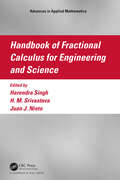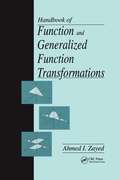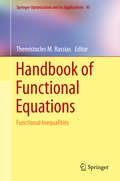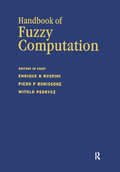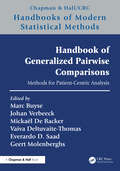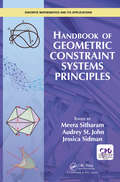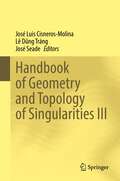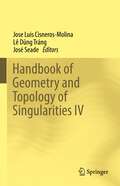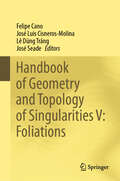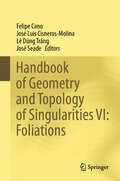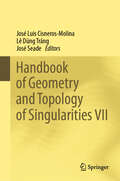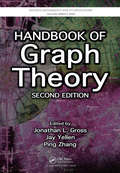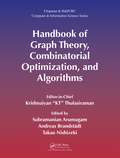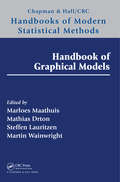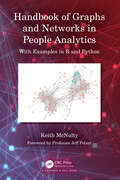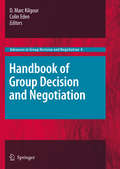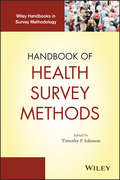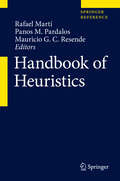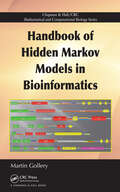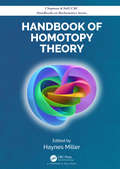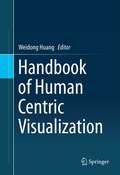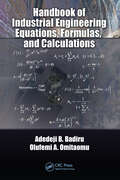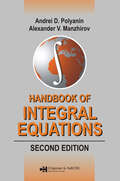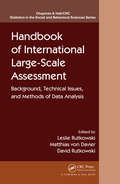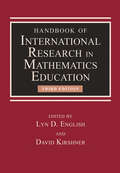- Table View
- List View
Handbook of Fractional Calculus for Engineering and Science (ISSN)
by H. M. Srivastava Harendra Singh Juan J. NietoFractional calculus is used to model many real-life situations from science and engineering. The book includes different topics associated with such equations and their relevance and significance in various scientific areas of study and research. In this book readers will find several important and useful methods and techniques for solving various types of fractional-order models in science and engineering. The book should be useful for graduate students, PhD students, researchers and educators interested in mathematical modelling, physical sciences, engineering sciences, applied mathematical sciences, applied sciences, and so on. This Handbook: Provides reliable methods for solving fractional-order models in science and engineering. Contains efficient numerical methods and algorithms for engineering-related equations. Contains comparison of various methods for accuracy and validity. Demonstrates the applicability of fractional calculus in science and engineering. Examines qualitative as well as quantitative properties of solutions of various types of science- and engineering-related equations. Readers will find this book to be useful and valuable in increasing and updating their knowledge in this field and will be it will be helpful for engineers, mathematicians, scientist and researchers working on various real-life problems.
Handbook of Function and Generalized Function Transformations
by Ahmed I. ZayedFunction transformations, which include linear integral transformations, are some of the most important mathematical tools for solving problems in all areas of engineering and the physical sciences. They allow one to quickly solve a problem by breaking it down into a series of smaller, more manageable problems.The author has compiled the most important and widely used of these function transforms in applied mathematics and electrical engineering. In addition to classical transforms, newer transforms such as wavelets, Zak, and Radon are included. The book is neither a table of transforms nor a textbook, but it is a source book that provides quick and easy access to the most important properties and formulas of function and generalized function transformations. It is organized for convenient reference, with chapters broken down into the following sections:
Handbook of Functional Equations
by Themistocles M. RassiasThis handbook consists of seventeen chapters written by eminent scientists from the international mathematical community, who present important research works in the field of mathematical analysis and related subjects, particularly in the Ulam stability theory of functional equations. The book provides an insight into a large domain of research with emphasis to the discussion of several theories, methods and problems in approximation theory, analytic inequalities, functional analysis, computational algebra and applications. The notion of stability of functional equations has its origins with S. M. Ulam, who posed the fundamental problem for approximate homomorphisms in 1940 and with D. H. Hyers, Th. M. Rassias, who provided the first significant solutions for additive and linear mappings in 1941 and 1978, respectively. During the last decade the notion of stability of functional equations has evolved into a very active domain of mathematical research with several applications of interdisciplinary nature. The chapters of this handbook focus mainly on both old and recent developments on the equation of homomorphism for square symmetric groupoids, the linear and polynomial functional equations in a single variable, the Drygas functional equation on amenable semigroups, monomial functional equation, the Cauchy-Jensen type mappings, differential equations and differential operators, operational equations and inclusions, generalized module left higher derivations, selections of set-valued mappings, D'Alembert's functional equation, characterizations of information measures, functional equations in restricted domains, as well as generalized functional stability and fixed point theory.
Handbook of Fuzzy Computation
by Enrique H Ruspini; Piero P Bonissone; Witold PedryczInitially conceived as a methodology for the representation and manipulation of imprecise and vague information, fuzzy computation has found wide use in problems that fall well beyond its originally intended scope of application. Many scientists and engineers now use the paradigms of fuzzy computation to tackle problems that are either intractable
Handbook of Generalized Pairwise Comparisons: Methods for Patient-Centric Analysis (Chapman & Hall/CRC Handbooks of Modern Statistical Methods)
by Marc Buyse Geert Molenberghs Johan Verbeeck Mickaël De Backer Vaiva Deltuvaite-Thomas Everardo D. SaadIn today's healthcare landscape, there is a pressing need for quantitative methodologies that include the patients' perspective in any treatment decision.Handbook of Generalized Pairwise Comparisons: Methods for Patient-Centric Analysis provides a comprehensive overview of an innovative and powerful statistical methodology that generalizes the traditional Wilcoxon-Mann-Whitney test by extending it to any number of outcomes of any type and including thresholds of clinical relevance into a single, multidimensional evaluation.The book covers the statistical foundations of generalized pairwise comparisons (GPC), applications in various disease areas, implications for regulatory approvals and benefit-risk analyses, and considerations for patient-centricity in clinical research. With contributions from leading experts in the field, this book stands as an essential resource for a more holistic and patient-centric assessment of treatment effects.
Handbook of Geometric Constraint Systems Principles (Discrete Mathematics and Its Applications)
by Meera Sitharam Audrey St. John Jessica SidmanThe Handbook of Geometric Constraint Systems Principles is an entry point to the currently used principal mathematical and computational tools and techniques of the geometric constraint system (GCS). It functions as a single source containing the core principles and results, accessible to both beginners and experts. The handbook provides a guide for students learning basic concepts, as well as experts looking to pinpoint specific results or approaches in the broad landscape. As such, the editors created this handbook to serve as a useful tool for navigating the varied concepts, approaches and results found in GCS research. <P><P>Key Features: <li>A comprehensive reference handbook authored by top researchers <li>Includes fundamentals and techniques from multiple perspectives that span several research communities <li>Provides recent results and a graded program of open problems and conjectures <li>Can be used for senior undergraduate or graduate topics course introduction to the area <li>Detailed list of figures and tables <P><P>About the Editors: <P><P>Meera Sitharam is currently an Associate Professor at the University of Florida’s Department of Computer & Information Science and Engineering. She received her Ph.D. at the University of Wisconsin, Madison. Audrey St. John is an Associate Professor of Computer Science at Mount Holyoke College, who received her Ph. D. from UMass Amherst. Jessica Sidman is a Professor of Mathematics on the John S. Kennedy Foundation at Mount Holyoke College. She received her Ph.D. from the University of Michigan.
Handbook of Geometry and Topology of Singularities III
by Lê Dũng Tráng José Luis Cisneros-Molina José SeadeThis is the third volume of the Handbook of Geometry and Topology of Singularities, a series which aims to provide an accessible account of the state of the art of the subject, its frontiers, and its interactions with other areas of research. This volume consists of ten chapters which provide an in-depth and reader-friendly survey of various important aspects of singularity theory. Some of these complement topics previously explored in volumes I and II, such as, for instance, Zariski’s equisingularity, the interplay between isolated complex surface singularities and 3-manifold theory, stratified Morse theory, constructible sheaves, the topology of the non-critical levels of holomorphic functions, and intersection cohomology. Other chapters bring in new subjects, such as the Thom–Mather theory for maps, characteristic classes for singular varieties, mixed Hodge structures, residues in complex analytic varieties, nearby and vanishing cycles, and more. Singularities are ubiquitous in mathematics and science in general. Singularity theory interacts energetically with the rest of mathematics, acting as a crucible where different types of mathematical problems interact, surprising connections are born and simple questions lead to ideas which resonate in other parts of the subject, and in other subjects. Authored by world experts, the various contributions deal with both classical material and modern developments, covering a wide range of topics which are linked to each other in fundamental ways. The book is addressed to graduate students and newcomers to the theory, as well as to specialists who can use it as a guidebook.
Handbook of Geometry and Topology of Singularities IV
by Lê Dũng Tráng José Luis Cisneros-Molina José SeadeThis is the fourth volume of the Handbook of Geometry and Topology of Singularities, a series that aims to provide an accessible account of the state of the art of the subject, its frontiers, and its interactions with other areas of research. This volume consists of twelve chapters which provide an in-depth and reader-friendly survey of various important aspects of singularity theory. Some of these complement topics previously explored in volumes I to III. Amongst the topics studied in this volume are the Nash blow up, the space of arcs in algebraic varieties, determinantal singularities, Lipschitz geometry, indices of vector fields and 1-forms, motivic characteristic classes, the Hilbert-Samuel multiplicity and comparison theorems that spring from the classical De Rham complex. Singularities are ubiquitous in mathematics and science in general. Singularity theory is a crucible where different types of mathematical problems interact, surprising connections are born and simple questions lead to ideas which resonate in other subjects. Authored by world experts, the various contributions deal with both classical material and modern developments, covering a wide range of topics which are linked to each other in fundamental ways. The book is addressed to graduate students and newcomers to the theory, as well as to specialists who can use it as a guidebook.
Handbook of Geometry and Topology of Singularities V: Foliations
by Lê Dũng Tráng Felipe Cano José Luis Cisneros-Molina José SeadeThis is the fifth volume of the Handbook of Geometry and Topology of Singularities, a series which aims to provide an accessible account of the state-of-the-art of the subject, its frontiers, and its interactions with other areas of research. Singularities are ubiquitous in mathematics and science in general, and singularity theory is a crucible where different types of mathematical problems converge, surprising connections are born and simple questions lead to ideas which resonate in other parts of the subject, and in other subjects. This Volume V focuses on singular holomorphic foliations, which is a multidisciplinary field and a whole area of mathematics in itself. Singular foliations arise, for instance, by considering: The fibers of a smooth map between differentiable manifolds, with singularities at the critical points. The integral lines of a vector field, or the action of a Lie group on a manifold. The singularities are the orbits with special isotropy. The kernel of appropriate 1-forms. The singularities are the zeros of the form. Open books, which naturally appear in singularity theory as foliations with singular set the binding. These important examples highlight the deep connections between foliations and singularity theory. This volume, like its companion Volume VI, also focused on foliations, consists of nine chapters, authored by world experts, which provide in-depth and reader-friendly introductions to some of the foundational aspects of the theory. These introductions also give insights into important lines of further research. The volume starts with a foreword by one of the current world leaders in the theory of complex foliations. The book is addressed to graduate students and newcomers to the theory, as well as to specialists who can use it as a guidebook.
Handbook of Geometry and Topology of Singularities VI: Foliations
by Lê Dũng Tráng Felipe Cano José Luis Cisneros-Molina José SeadeThis is the sixth volume of the Handbook of Geometry and Topology of Singularities, a series which aims to provide an accessible account of the state-of-the-art of the subject, its frontiers, and its interactions with other areas of research. Singularities are ubiquitous in mathematics and science in general, and singularity theory is a crucible where different types of mathematical problems converge, surprising connections are born and simple questions lead to ideas which resonate in other parts of the subject, and in other subjects.This Volume VI goes together with Volume V and focuses on singular holomorphic foliations, which is a multidisciplinary field and a whole area of mathematics in itself. Singular foliations arise, for instance, by considering:The fibers of a smooth map between differentiable manifolds, with singularities at the critical points.The integral lines of a vector field, or the action of a Lie group on a manifold. The singularities are the orbits with special isotropy.The kernel of appropriate 1-forms. The singularities are the zeroes of the form.Open books, which naturally appear in singularity theory, are foliations with singular set the binding.These important examples highlight the deep connections between foliations and singularity theory. This volume consists of nine chapters, authored by world experts, which provide in-depth and reader-friendly introductions to some of the foundational aspects of the theory. These introductions also give insights into important lines of further research. Volume VI ends with an Epilogue by one of the current world leaders in the theory of complex foliations, with plenty of open questions and ideas for further research.The book is addressed to graduate students and newcomers to the theory, as well as to specialists who can use it as a guidebook.
Handbook of Geometry and Topology of Singularities VII
by Lê Dũng Tráng José Luis Cisneros-Molina José SeadeThis is the seventh volume of the Handbook of Geometry and Topology of Singularities, a series that aims to provide an accessible account of the state of the art of the subject, its frontiers, and its interactions with other areas of research. This volume consists of fourteen chapters that provide an in-depth and reader-friendly introduction to various important aspects of singularity theory. The volume begins with an outstanding exposition on Jim Damon’s contributions to singularity theory and its applications. Jim passed away in 2022 and he was one of the greatest mathematicians of recent times, having made remarkable contributions to singularity theory and its applications, mostly to medical image computing. The next chapter focuses on the singularities of real functions and their bifurcation sets. Then, we look at the perturbation theory of polynomials and linear operators, complex analytic frontal singularities, the global singularity theory of differentiable maps, and the singularities of holomorphic functions from a global point of view. The volume continues with an overview of new tools in singularity theory that spring from symplectic geometry and Floer-type homology theories. Then, it looks at the derivation of Lie algebras of isolated singularities and the three-dimensional rational isolated complete intersection singularities, as well as recent developments in algebraic K-stability and the stable degeneration conjecture. This volume also contains an interesting survey on V-filtrations, a theory began by Malgrange and Kashiwara that can be used to study nearby and vanishing cycle functors and introduced by Deligne. Then, we present a panoramic view of the Hodge, toric, and motivic methods in the study of Milnor fibers in singularity theory, both from local and global points of view. The Monodromy conjecture is also explained; this is a longstanding open problem in singularity theory that lies at the crossroads of number theory, algebra, analysis, geometry, and topology. This volume closes with recent developments in the study of the algebraic complexity of optimization problems in applied algebraic geometry and algebraic statistics. The book is addressed to graduate students and newcomers to the theory, as well as to specialists who can use it as a guidebook.
Handbook of Graph Theory (Discrete Mathematics And Its Applications Ser.)
by Ping Zhang Jonathan L. Gross Jay YellenIn the ten years since the publication of the best-selling first edition, more than 1,000 graph theory papers have been published each year. Reflecting these advances, Handbook of Graph Theory, Second Edition provides comprehensive coverage of the main topics in pure and applied graph theory. This second edition-over 400 pages longer than its prede
Handbook of Graph Theory, Combinatorial Optimization, and Algorithms (Chapman & Hall/CRC Computer and Information Science Series #34)
by Andreas Brandstädt Subramanian Arumugam Takao NishizekiThis handbook is the first to present a unified, comprehensive treatment of graph theory, combinatorial optimization, and related algorithmic issues. It covers numerous topics of interest in applications in electrical, communication, computer, social, transportation, biological, and other networks. The book provides readers with the algorithmic and theoretical foundations to understand phenomena as shaped by their graph structures, develop needed algorithmic and optimization tools for the study of graph structures, and design and plan graph structures that lead to certain desirable behavior.
Handbook of Graphical Models (Chapman & Hall/CRC Handbooks of Modern Statistical Methods)
by Steffen Lauritzen Martin Wainwright Marloes Maathuis Mathias DrtonA graphical model is a statistical model that is represented by a graph. The factorization properties underlying graphical models facilitate tractable computation with multivariate distributions, making the models a valuable tool with a plethora of applications. Furthermore, directed graphical models allow intuitive causal interpretations and have become a cornerstone for causal inference. While there exist a number of excellent books on graphical models, the field has grown so much that individual authors can hardly cover its entire scope. Moreover, the field is interdisciplinary by nature. Through chapters by leading researchers from different areas, this handbook provides a broad and accessible overview of the state of the art. Key features: * Contributions by leading researchers from a range of disciplines * Structured in five parts, covering foundations, computational aspects, statistical inference, causal inference, and applications * Balanced coverage of concepts, theory, methods, examples, and applications * Chapters can be read mostly independently, while cross-references highlight connections The handbook is targeted at a wide audience, including graduate students, applied researchers, and experts in graphical models.
Handbook of Graphs and Networks in People Analytics: With Examples in R and Python
by Keith McNultyHandbook of Graphs and Networks in People Analytics: With Examples in R and Python covers the theory and practical implementation of graph methods in R and Python for the analysis of people and organizational networks. Starting with an overview of the origins of graph theory and its current applications in the social sciences, the book proceeds to give in-depth technical instruction on how to construct and store graphs from data, how to visualize those graphs compellingly and how to convert common data structures into graph-friendly form. The book explores critical elements of network analysis in detail, including the measurement of distance and centrality, the detection of communities and cliques, and the analysis of assortativity and similarity. An extension chapter offers an introduction to graph database technologies. Real data sets from various research contexts are used for both instruction and for end of chapter practice exercises and a final chapter contains data sets and exercises ideal for larger personal or group projects of varying difficulty level. Key features: Immediately implementable code, with extensive and varied illustrations of graph variants and layouts. Examples and exercises across a variety of real-life contexts including business, politics, education, social media and crime investigation. Dedicated chapter on graph visualization methods. Practical walkthroughs of common methodological uses: finding influential actors in groups, discovering hidden community structures, facilitating diverse interaction in organizations, detecting political alignment, determining what influences connection and attachment. Various downloadable data sets for use both in class and individual learning projects. Final chapter dedicated to individual or group project examples.
Handbook of Group Decision and Negotiation
by Colin Eden D. Marc KilgourThe field of Group Decision and Negotiation can be described as the empirical, formal, computational, and strategic analysis of group decision-making and negotiation, especially from the points of view of Management Science and Operations Research. Group Decision and Negotiation crosses many traditional disciplinary boundaries, and has connections to business administration and business strategy, management science, systems engineering, computer science, mathematics, and law, as well as economics, psychology, and other social sciences. The Handbook of Group Decision and Negotiation is intended to become the major reference in the field. The only current references are the highly successful journal Group Decision and Negotiation, as well as the books of the Advances in Group Decision and Negotiation series, and a few other journals. Researchers, students, and practitioners in this growing field sorely need a good general reference.
Handbook of Health Survey Methods
by Timothy P. JohnsonA comprehensive guidebook to the current methodologies and practices used in health surveysA unique and self-contained resource, Handbook of Health Survey Methods presents techniques necessary for confronting challenges that are specific to health survey research. The handbook guides readers through the development of sample designs, data collection procedures, and analytic methods for studies aimed at gathering health information on general and targeted populations.The book is organized into five well-defined sections: Design and Sampling Issues, Measurement Issues, Field Issues, Health Surveys of Special Populations, and Data Management and Analysis. Maintaining an easy-to-follow format, each chapter begins with an introduction, followed by an overview of the main concepts, theories, and applications associated with each topic. Finally, each chapter provides connections to relevant online resources for additional study and reference. The Handbook of Health Survey Methods features:29 methodological chapters written by highly qualified experts in academia, research, and industryA treatment of the best statistical practices and specific methodologies for collecting data from special populations such as sexual minorities, persons with disabilities, patients, and practitionersDiscussions on issues specific to health research including developing physical health and mental health measures, collecting information on sensitive topics, sampling for clinical trials, collecting biospecimens, working with proxy respondents, and linking health data to administrative and other external data sourcesNumerous real-world examples from the latest research in the fields of public health, biomedicine, and health psychologyHandbook of Health Survey Methods is an ideal reference for academics, researchers, and practitioners who apply survey methods and analyze data in the fields of biomedicine, public health, epidemiology, and biostatistics. The handbook is also a useful supplement for upper-undergraduate and graduate-level courses on survey methodology.
Handbook of Heuristics
by Panos M. Pardalos Rafael Martí Mauricio G. ResendeHeuristics are strategies using readily accessible, loosely applicable information to control problem solving. Algorithms, for example, are a type of heuristic. By contrast, Metaheuristics are methods used to design Heuristics and may coordinate the usage of several Heuristics toward the formulation of a single method. GRASP (Greedy Randomized Adaptive Search Procedures) is an example of a Metaheuristic. To the layman, heuristics may be thought of as ‘rules of thumb’ but despite its imprecision, heuristics is a very rich field that refers to experience-based techniques for problem-solving, learning, and discovery. Any given solution/heuristic is not guaranteed to be optimal but heuristic methodologies are used to speed up the process of finding satisfactory solutions where optimal solutions are impractical. The introduction to this Handbook provides an overview of the history of Heuristics along with main issues regarding the methodologies covered. This is followed by Chapters containing various examples of local searches, search strategies and Metaheuristics, leading to an analyses of Heuristics and search algorithms. The reference concludes with numerous illustrations of the highly applicable nature and implementation of Heuristics in our daily life. Each chapter of this work includes an abstract/introduction with a short description of the methodology. Key words are also necessary as part of top-matter to each chapter to enable maximum search engine optimization. Next, chapters will include discussion of the adaptation of this methodology to solve a difficult optimization problem, and experiments on a set of representative problems.
Handbook of Hidden Markov Models in Bioinformatics
by Martin GolleryDemonstrating that many useful resources, such as databases, can benefit most bioinformatics projects, the Handbook of Hidden Markov Models in Bioinformatics focuses on how to choose and use various methods and programs available for hidden Markov models (HMMs).The book begins with discussions on key HMM and related profile methods, incl
Handbook of Homotopy Theory (CRC Press/Chapman and Hall Handbooks in Mathematics Series)
by Haynes MillerThe Handbook of Homotopy Theory provides a panoramic view of an active area in mathematics that is currently seeing dramatic solutions to long-standing open problems, and is proving itself of increasing importance across many other mathematical disciplines. The origins of the subject date back to work of Henri Poincaré and Heinz Hopf in the early 20th century, but it has seen enormous progress in the 21st century. A highlight of this volume is an introduction to and diverse applications of the newly established foundational theory of ¥ -categories. The coverage is vast, ranging from axiomatic to applied, from foundational to computational, and includes surveys of applications both geometric and algebraic. The contributors are among the most active and creative researchers in the field. The 22 chapters by 31 contributors are designed to address novices, as well as established mathematicians, interested in learning the state of the art in this field, whose methods are of increasing importance in many other areas.
Handbook of Human Centric Visualization
by Weidong HuangVisualizations are visual representations of non-visual data. They are produced for people to interact with and to make sense of the underlying data. Rapid advances in display technology and computer power have enabled researchers to produce visually appealing pictures. However, the effectiveness of those pictures in conveying the embedded information to end users has not been fully explored. Handbook of Human Centric Visualization addresses issues related to design, evaluation and application of visualizations. Topics include visualization theories, design principles, evaluation methods and metrics, human factors, interaction methods and case studies. This cutting-edge book includes contributions from well-established researchers worldwide, from diverse disciplines including psychology, visualization and human-computer interaction. This handbook is designed for a professional audience composed of practitioners, lecturers and researchers working in the field of computer graphics, visualization, human-computer interaction and psychology. Undergraduate and postgraduate students in science and engineering focused on this topic will also find this book useful as a comprehensive textbook or reference.
Handbook of Industrial Engineering Equations, Formulas, and Calculations (Systems Innovation Book Series)
by Adedeji B. Badiru Olufemi A. OmitaomuThe first handbook to focus exclusively on industrial engineering calculations with a correlation to applications, Handbook of Industrial Engineering Equations, Formulas, and Calculations contains a general collection of the mathematical equations often used in the practice of industrial engineering. Many books cover individual areas of engineering
Handbook of Integral Equations: Second Edition
by Alexander V. Manzhirov Polyanin PolyaninUnparalleled in scope compared to the literature currently available, the Handbook of Integral Equations, Second Edition contains over 2,500 integral equations with solutions as well as analytical and numerical methods for solving linear and nonlinear equations. It explores Volterra, Fredholm, Wiener�Hopf, Hammerstein, Uryson, and other equa
Handbook of International Large-Scale Assessment: Background, Technical Issues, and Methods of Data Analysis (Chapman & Hall/CRC Statistics in the Social and Behavioral Sciences #13)
by Matthias Von Davier Leslie Rutkowski David RutkowskiWinner of the 2017 AERA Division D Significant Contribution to Educational Measurement and Research Methodology Award!Technological and statistical advances, along with a strong interest in gathering more information about the state of our educational systems, have made it possible to assess more students, in more countries, more often, and in more subject domains. The Handbook of International Large-Scale Assessment: Background, Technical Issues, and Methods of Data Analysis brings together recognized scholars in the field of ILSA, behavioral statistics, and policy to develop a detailed guide that goes beyond database user manuals. After highlighting the importance of ILSA data to policy and research, the book reviews methodological aspects and features of the studies based on operational considerations, analytics, and reporting. The book then describes methods of interest to advanced graduate students, researchers, and policy analysts who have a good grounding in quantitative methods, but who are not necessarily quantitative methodologists. In addition, it provides a detailed exposition of the technical details behind these assessments, including the test design, the sampling framework, and estimation methods, with a focus on how these issues impact analysis choices.
Handbook of International Research in Mathematics Education (100 Cases Ser.)
by Lyn D. English David KirshnerThis third edition of the Handbook of International Research in Mathematics Education provides a comprehensive overview of the most recent theoretical and practical developments in the field of mathematics education. Authored by an array of internationally recognized scholars and edited by Lyn English and David Kirshner, this collection brings together overviews and advances in mathematics education research spanning established and emerging topics, diverse workplace and school environments, and globally representative research priorities. New perspectives are presented on a range of critical topics including embodied learning, the theory-practice divide, new developments in the early years, educating future mathematics education professors, problem solving in a 21st century curriculum, culture and mathematics learning, complex systems, critical analysis of design-based research, multimodal technologies, and e-textbooks. Comprised of 12 revised and 17 new chapters, this edition extends the Handbook’s original themes for international research in mathematics education and remains in the process a definitive resource for the field.
